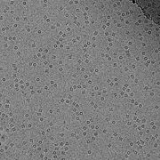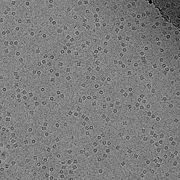
Cryo-electron microscopy
Encyclopedia

Liquid nitrogen
Liquid nitrogen is nitrogen in a liquid state at a very low temperature. It is produced industrially by fractional distillation of liquid air. Liquid nitrogen is a colourless clear liquid with density of 0.807 g/mL at its boiling point and a dielectric constant of 1.4...
temperatures). Cryo-EM is developing popularity in structural biology
Structural biology
Structural biology is a branch of molecular biology, biochemistry, and biophysics concerned with the molecular structure of biological macromolecules, especially proteins and nucleic acids, how they acquire the structures they have, and how alterations in their structures affect their function...
.
The popularity of cryoelectron microscopy stems from the fact that it allows the observation of specimens that have not been stained or fixed in any way, showing them in their native environment, in contrast to X-ray crystallography
X-ray crystallography
X-ray crystallography is a method of determining the arrangement of atoms within a crystal, in which a beam of X-rays strikes a crystal and causes the beam of light to spread into many specific directions. From the angles and intensities of these diffracted beams, a crystallographer can produce a...
, which generally requires placing the samples in non-physiological environments, which can occasionally lead to functionally irrelevant conformational changes. In practice, the resolution of cryo-electron microscopy maps is not high enough to allow for unambiguous model construction on the basis of EM maps only, and models obtained by protein crystallography are used to interpret the cryo-EM maps. However, the resolution of cryo-EM maps is improving steadily, and some virus structures obtained by cryo-EM are already at a resolution that can be interpreted in terms of an atomic model.
A version of electron cryomicroscopy is cryo-electron tomography
Cryo-electron tomography
Cryo-electron tomography is a type of electron cryomicroscopy where tomography is used to obtain a 3D reconstruction of a sample from tilted 2D images at cryogenic temperatures....
(CET) where a 3D reconstruction of a sample is created from tilted 2D images.
Development
The original rationale for cryoelectron microscopy was as a means to fight radiation damageRadiation damage
Radiation damage is a term associated with ionizing radiation.-Causes:This radiation may take several forms:*Cosmic rays and subsequent energetic particles caused by their collision with the atmosphere and other materials....
for biological specimens. The amount of radiation required to collect an image of a specimen in the electron microscope
Electron microscope
An electron microscope is a type of microscope that uses a beam of electrons to illuminate the specimen and produce a magnified image. Electron microscopes have a greater resolving power than a light-powered optical microscope, because electrons have wavelengths about 100,000 times shorter than...
is comparable to placing the sample about 20 m away from a thermonuclear device. In addition, the high vacuum
High Vacuum
High Vacuum is a science fiction novel by Charles Eric Maine. It was first published in 1957 by Ballantine Books.-Synopsis:The first manned moon ship, Alpha, runs out of fuel just before landing in the Mare Imbrium, and crashes, killing one of the four-man crew and marooning the rest...
required on the column of an electron microscope makes the environment for the sample quite harsh.
The problem of the vacuum was partially solved by the introduction of negative stain
Negative stain
Negative staining is an established method, often used in diagnostic microscopy, for contrasting a thin specimen with an optically opaque fluid....
s such as uranium salts (uranyl acetate
Uranyl acetate
Uranyl acetate is the acetate salt of uranium and is a yellow crystalline solid made up of yellow rhombic crystals and has a slight acetic odor. Uranyl acetate is slightly radioactive, the precise radioactivity depends on the isotopes of uranium present...
is perhaps the most common negative stain), but even with negative stains, biological samples are prone to structural collapse upon dehydration
Dehydration
In physiology and medicine, dehydration is defined as the excessive loss of body fluid. It is literally the removal of water from an object; however, in physiological terms, it entails a deficiency of fluid within an organism...
of the specimen. Embedding the samples in ice below the sublimation temperature was a possibility that was contemplated early on, but water tends to arrange into a crystalline lattice of lower density upon freezing and this tends to destroy the structure of anything that is embedded in it.
In the early 80's, several groups studying solid state physics were attempting to produce vitreous ice by different means, such as high pressure freezing or flash freezing. Theoretical calculations deemed this task impossible, but in a seminal paper in 1984, the group led by Jacques Dubochet at the European Molecular Biology Laboratory
European Molecular Biology Laboratory
The European Molecular Biology Laboratory is a molecular biology research institution supported by 20 European countries and Australia as associate member state. EMBL was created in 1974 and is an intergovernmental organisation funded by public research money from its member states...
showed images of adenovirus embedded in a vitrified layer of water. This paper is generally considered to mark the birth of cryoelectron microscopy, and the technique has been developed to the point of becoming routine at several laboratories throughout the world.
Thin film
The biological material is spread on an electron microscopy grid and is preserved in a frozen-hydrated stateAmorphous ice
Amorphous ice is an amorphous solid form of water, meaning it consists of water molecules that are randomly arranged like the atoms of common glass. Everyday ice is a crystalline material where the atoms are regularly arranged in a lattice whereas amorphous ice is distinguished by a lack of...
by rapid freezing, usually in liquid ethane
Ethane
Ethane is a chemical compound with chemical formula C2H6. It is the only two-carbon alkane that is an aliphatic hydrocarbon. At standard temperature and pressure, ethane is a colorless, odorless gas....
near liquid nitrogen
Liquid nitrogen
Liquid nitrogen is nitrogen in a liquid state at a very low temperature. It is produced industrially by fractional distillation of liquid air. Liquid nitrogen is a colourless clear liquid with density of 0.807 g/mL at its boiling point and a dielectric constant of 1.4...
temperature. By maintaining specimens at liquid nitrogen temperature or colder, they can be introduced into the high-vacuum
Vacuum
In everyday usage, vacuum is a volume of space that is essentially empty of matter, such that its gaseous pressure is much less than atmospheric pressure. The word comes from the Latin term for "empty". A perfect vacuum would be one with no particles in it at all, which is impossible to achieve in...
of the electron microscope
Electron microscope
An electron microscope is a type of microscope that uses a beam of electrons to illuminate the specimen and produce a magnified image. Electron microscopes have a greater resolving power than a light-powered optical microscope, because electrons have wavelengths about 100,000 times shorter than...
column. Most biological specimens are extremely radiation
Radiation
In physics, radiation is a process in which energetic particles or energetic waves travel through a medium or space. There are two distinct types of radiation; ionizing and non-ionizing...
sensitive, so they must be imaged with low-dose techniques (usefully, the low temperature of cryo-electron microscopy provides an additional protective factor against radiation
Radiation
In physics, radiation is a process in which energetic particles or energetic waves travel through a medium or space. There are two distinct types of radiation; ionizing and non-ionizing...
damage).
Consequently, the images are extremely noisy. For some biological systems it is possible to average images to increase the signal-to-noise ratio and retrieve high-resolution information about the specimen using the technique known as single particle analysis
Single particle analysis
Single Particle Analysis is a group of related of computerized image processing techniques used to analyze images from transmission electron microscopy . These methods were developed to improve and extend the information obtainable from TEM images of particulate samples, typically proteins or...
. This approach in general requires that the things being averaged are identical, although some limited conformational heterogeneity can now be studied (e.g. ribosome
Ribosome
A ribosome is a component of cells that assembles the twenty specific amino acid molecules to form the particular protein molecule determined by the nucleotide sequence of an RNA molecule....
). Three dimensional reconstructions from cryo-EM images of protein complexes and virus
Virus
A virus is a small infectious agent that can replicate only inside the living cells of organisms. Viruses infect all types of organisms, from animals and plants to bacteria and archaea...
es have been solved to sub-nanometer or near-atomic resolution, allowing new insights into the structure and biology of these large assemblies.
Analysis of ordered arrays of protein, such as 2-D crystals of transmembrane proteins or helical arrays of proteins, also allows a kind of averaging which can provide high-resolution information about the specimen. This technique is called electron crystallography
Electron crystallography
Electron crystallography is a method to determine the arrangement of atoms in solids using a transmission electron microscope .- Comparison with X-ray crystallography :...
.
Vitreous sections
The thin film method is limited to thin specimens (typically < 500 nm) because the electrons cannot cross thicker samples without multiple scattering events. Thicker specimens can be vitrified by plunge freezing (cryofixationCryofixation
Cryofixation is a technique for fixation or stabilisation of biological materials as the first step in specimen preparation for electron microscopy...
) in ethane (up to tens of μm in thickness) or more commonly by high pressure freezing (up to hundreds of μm). They can then be cut in thin sections (40 to 200 nm thick) with a diamond knife in a cryoultramicrotome at temperatures lower than -135 °C (devitrification temperature). The sections are collected on an electron microscope grid and are imaged in the same manner as specimen vitrified in thin film. This technique is called cryo-electron microscopy of vitreous sections (CEMOVIS) or cryo-electron microscopy of frozen-hydrated sections.
Techniques in cryoelectron microscopy
Cryoelectron microscopy has a variety of techniques which can be used. Three most popular ones are:- Single particle analysisSingle particle analysisSingle Particle Analysis is a group of related of computerized image processing techniques used to analyze images from transmission electron microscopy . These methods were developed to improve and extend the information obtainable from TEM images of particulate samples, typically proteins or...
- Cryo-electron tomographyElectron tomographyElectron Tomography is a tomography technique for obtaining detailed 3D structures of subcellular macromolecular objects. Electron tomography is an extension of traditional transmission electron microscopy and uses a transmission electron microscope to collect the data...
- Freeze trapping
See also
- Software tools for molecular microscopy
- Single particle analysisSingle particle analysisSingle Particle Analysis is a group of related of computerized image processing techniques used to analyze images from transmission electron microscopy . These methods were developed to improve and extend the information obtainable from TEM images of particulate samples, typically proteins or...
- Resolution (electron density)Resolution (electron density)Resolution in terms of electron density is a measure of the resolvability in the electron density map of a molecule. In X-ray crystallography, resolution is the highest resolvable peak in the diffraction pattern...
- EM Data BankEM Data BankThe EM Data Bank or Electron Microscopy Data Bank collects 3D EM maps and associated experimental data determined using electron microscopy of biological specimens...
External links
- The Fine Structure of a Frozen Virus - Sophisticated single-particle electron cryomicroscopy reveals unprecedented details in a virus's protein coat, Technology Review, March 19, 2008
Primary database:

